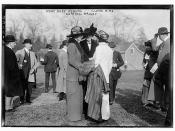"The Shining Houses" by Alice Munro uses Mary's point of view to show how younger generations mistreat the older ones.
Mrs. Fullerton, one who is of the older generation, is an individual that does not fit in with her new, younger neighbors. Despite that, Mary gives her and her story credence. However, Mary feels the division between Mrs. Fullerton's generation, and the younger one that she is a part of, as she felt as though she was going through barricades when going from Mrs. Fullerton's offbeat house to the subdivision's uniform houses. Mrs. Fullerton is like her house; different, self-sufficient and lasting.
Because of the generation gap, Mary's neighbors and Mrs. Fullerton have different values. Mary's neighbors, the "shining houses," are superficial and selfish. They are unaware that their values will one day lead to their destruction, as the future generations will flow with the cycle, the story's theme.
They were fuelled by their only strength: "self-assertion and anger." The "shining houses" appreciate their identical subdivision, and sacrifice individuality for aesthetics. Though refusing to sign the petition that hoped to drive Mrs. Fullerton out, wouldn't make a big difference, Mary stands up for what she saw was just, and though all she could do was walk away with hands in her pocket, she was not defeated.
Mary, a member of the younger generation and like every other resident of Garden Place, "did not talk to many old people any more" and owned a house that looked like the one beside and across it. Mary, knowing both sides, and has heard both Mrs. Fullerton and her neighbors' stories, is in a dilemma. She sacrifices being the topic of gossip at the next coffee party and asserts her position as one who does not care how things look and stands up for Mrs. Fullerton. Mary differs from every other resident of Garden Place by showing vulnerability while her discrete refusal to conform with the others imperceptibly bridges the division between the two generations.





